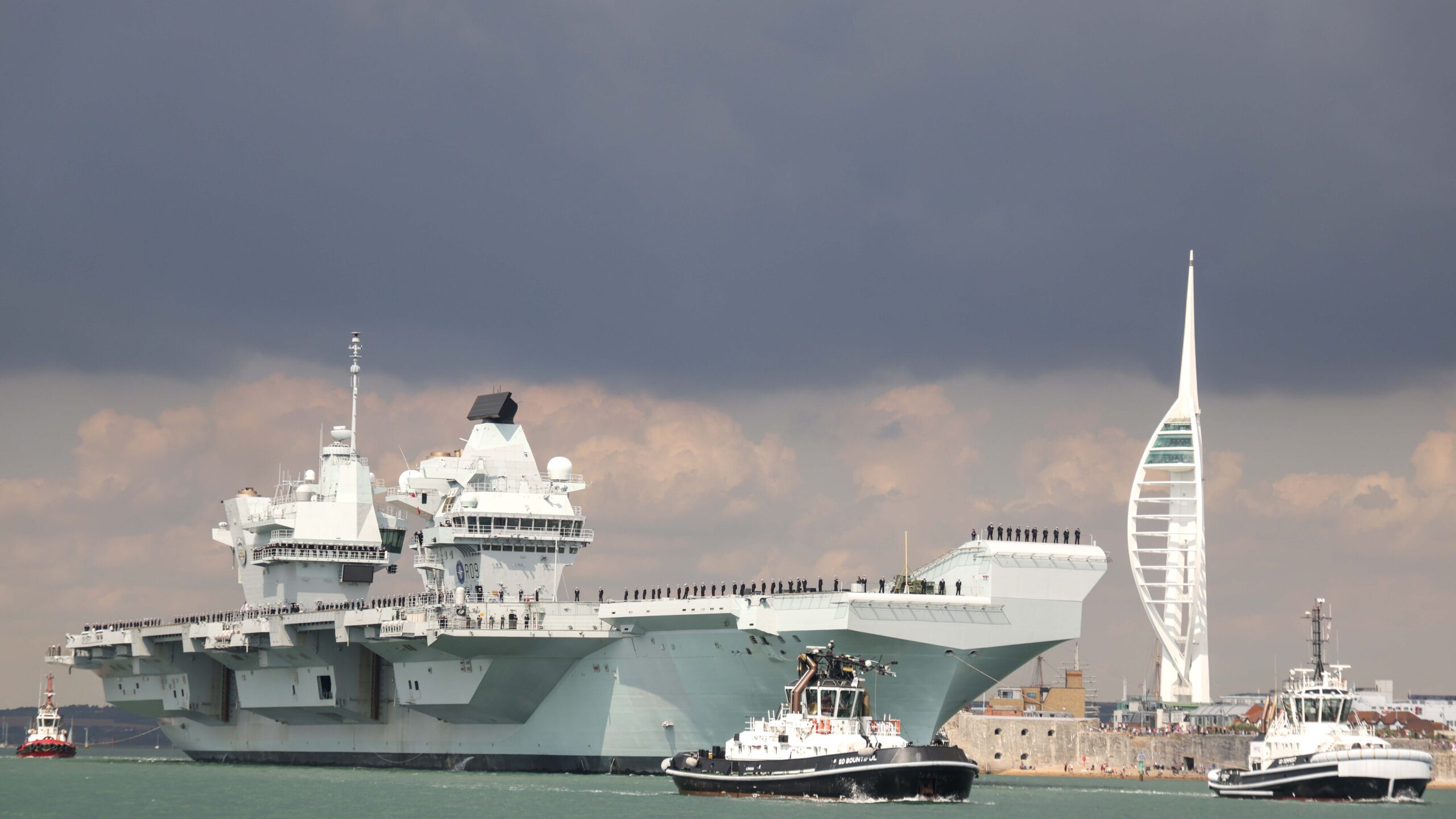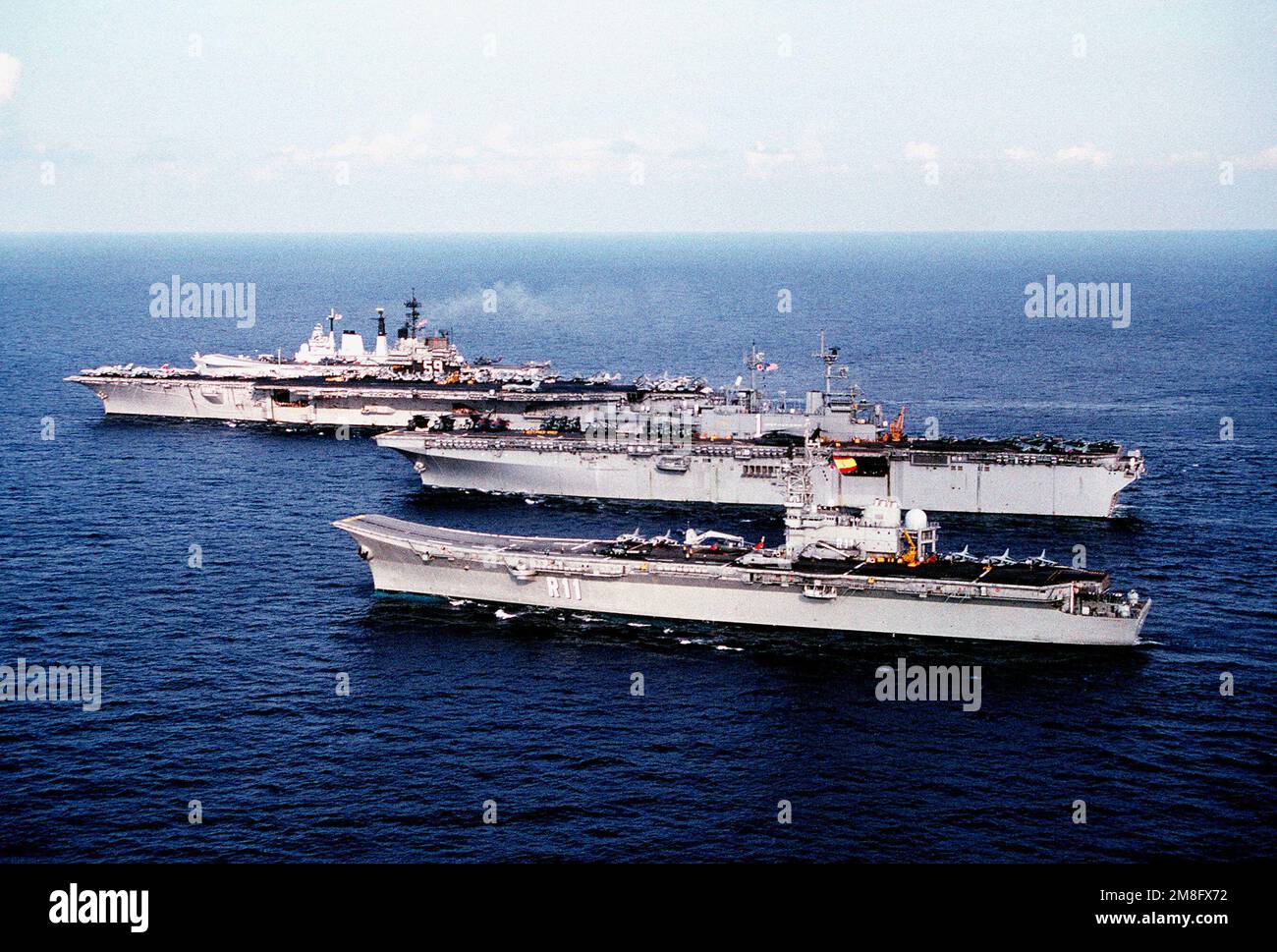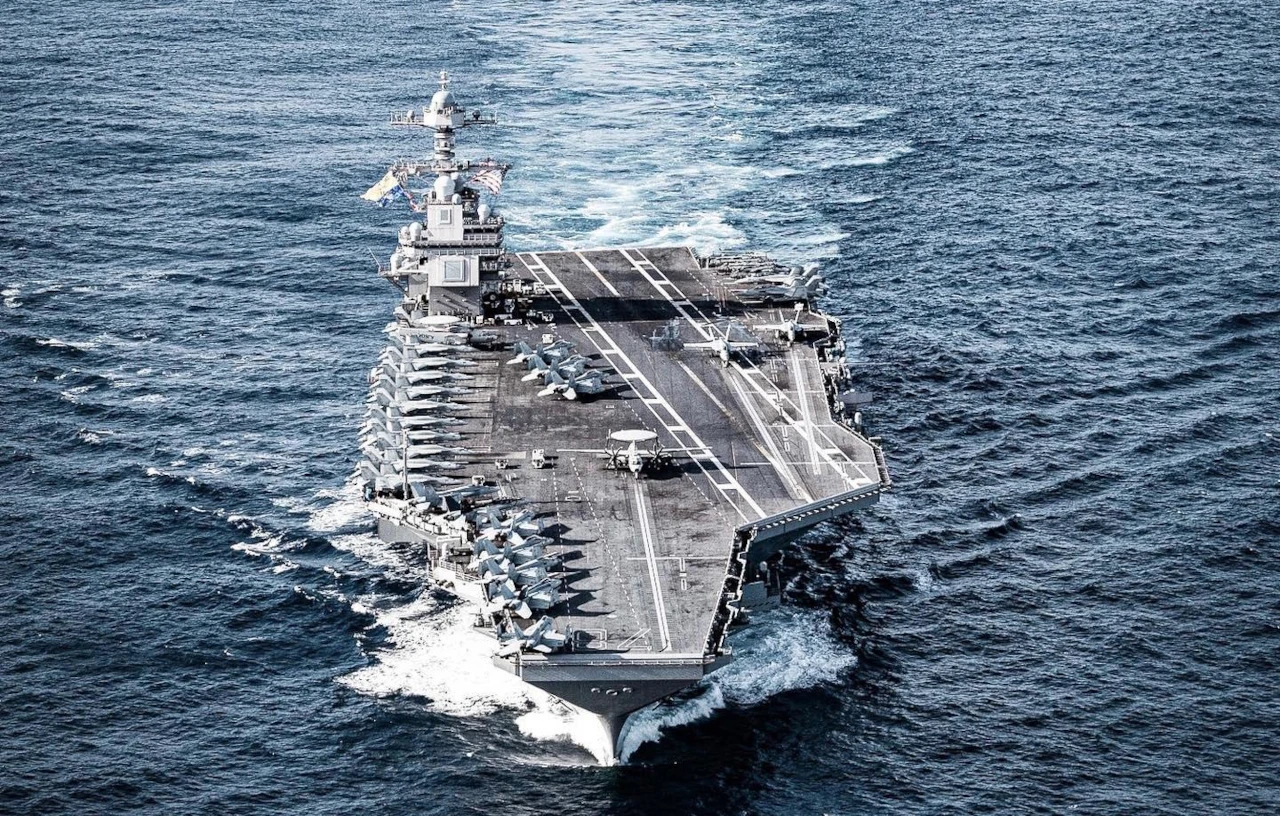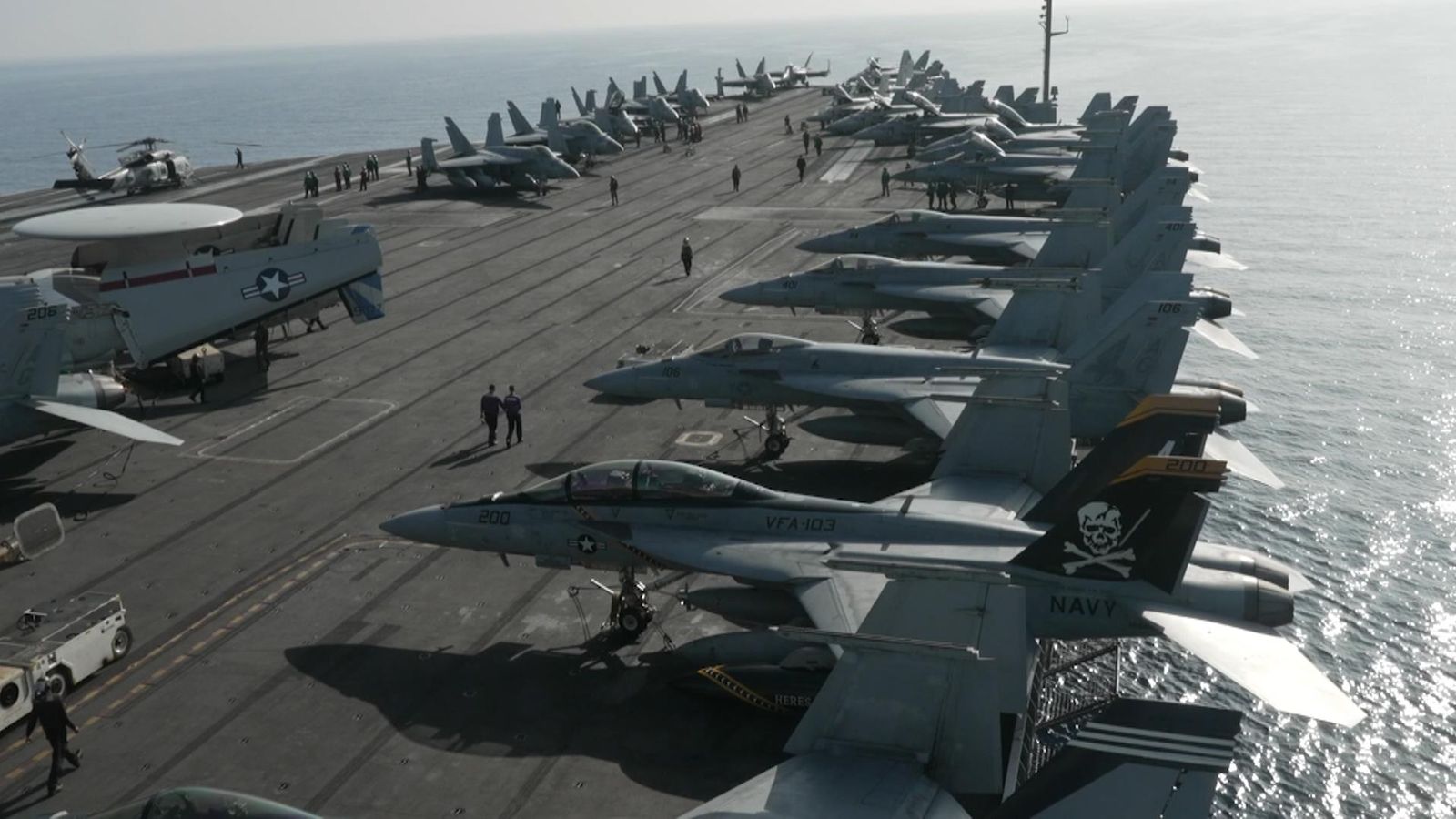Nato Aircraft Carriers - Marshal Ustinov reportedly passed through the Strait of Gibraltar yesterday and Automated Information System (AIS) transmissions provided by VesselFinder and MarineTraffic appear to confirm that it's now in the Mediterranean. It should be noted that AIS transmissions can be faked, and have been in the past, but at least some analysts consider it at least highly credible that these are genuine.
Regardless of whether all three Slavas end up in the Mediterranean, the warships there now are likely to be monitored by ships and aircraft from one or more of the three NATO carrier groups. Earlier today, unconfirmed reports suggested that Marshal Ustinov was being shadowed by the Arleigh Burke class destroyer USS Roosevelt (DDG-80), having arrived in the Mediterranean after participating in controversial live-fire exercises off the southern coast of Ireland.
Nato Aircraft Carriers

Three different NATO carrier groups are conducting joint operations in the Mediterranean Sea in a powerful demonstration of the alliance's maritime power as the East-West crisis over Ukraine continues. The latest drills involve the Harry S. Truman Carrier Strike Group, or HSTCSG, which has been integrating over a two-day period with the French Task Force 473, centered on the carrier Charles de Gaulle, and an Italian strike group based around the carrier
Cavour. Alongside all this, the Russian Navy has also been engaged in a flurry of activity in the region, with a host of different warship movements taking place against the backdrop of the situation in Ukraine.
In October 2022, the Bush Carrier Strike Group was placed under NATO control as part of Exercise Neptune Strike 22.2. Truman and his strike group had operated under the control of NATO during a previous iteration of Neptune Strike earlier in January, which was the first time the alliance had direct command and control of an American carrier since the end of the Cold War.
The U.S. Navy's Nimitz class carrier USS George H.W. Bush is operating separately in the Adriatic Sea as part of his scheduled deployment, with a stated mission to help "defend U.S., allied and partner interests." Bush's strike group consists of CVW 7 – which is organized in largely the same way as Ford's CVW 8 – as well as a number of escorts, the Ticonderoga class cruiser USS Leyte Gulf and four Arleigh Burke class destroyers.
For time being, we simply don't know whether the various Russian Navy assets that have been passing into the Mediterranean and into the Black Sea will be involved in some kind of operation relating to Ukraine, or even if they are intended to serve as a
distraction. However, as long as tensions continue in the region, we are likely to continue to see high-profile NATO maritime movements. While they may have been planned for some time, the powerful signaling of these latest tri-carrier operations is unlikely to have gone unnoticed.
Jared Keller is the managing editor of Task & Purpose. His writing has appeared in Aeon, the Los Angeles Review of Books, the New Republic, Pacific Standard, Smithsonian, and The Washington Post, among other publications. Contact the author here.

Bush arrived in the region in August, where he relieved USS Harry S. Truman and its associated strike group. The Truman Carrier Strike Group's deployment in European waters had been extended in light of Russia's all-out invasion of Ukraine in February.
"The level of trust developed between the U.S. and allied forces throughout our time in the theater, including past iterations of NEST and other bi- and multi-lateral operations, will pay dividends going forward," said Rear Adm.
Dennis Velez, commander of the Bush CSG. "Our national security - as well as Euro-Atlantic security - draws upon the strength of teamwork and our common purpose as allied nations." This current round of multicarrier operations comes just months after both the Bush and next-generation USS Gerald R. Ford aircraft carrier integrated with the French Navy's Charles de Gaulle aircraft carrier, the Cavour, and the United Kingdom's HMS Queen Elizabeth aircraft carrier for an unprecedented
five-carrier maritime exercise party back in November. Three NATO aircraft carriers from the United States, Italy, and Spain just wrapped up multicarrier operations in the Mediterranean Sea as part of the USS George H.W. Bush Carrier Strike Group's scheduled deployment to the U.S.
Naval Forces Europe area of operations. "The Harry S. Truman Carrier Strike Group has had the extraordinary chance to work with some of the finest maritime operators in the region and have been looking forward to training with our Italian and French allies," said Rear Adm.
Curt Renshaw, commander, Carrier Strike Group Eight, in a statement. "The capabilities of a U.S. aircraft carrier strike group are made stronger by operating alongside our allies and partners, and adding the French and Italian carrier teams provides an exciting chance to strengthen our interoperability together."
Ford, which was beset by technical issues and other problems for years, even after its formal delivery to the Navy, is on its first formal operational deployment, which the service has described as more of an operational evaluation, as you can read more about here
. The carrier left its homeport at Naval Station Norfolk in Virginia in October. By Jared Keller | Published Mar 2, 2023 11:51 AM EST Generally, however, it's less common for Northern Fleet and Pacific Fleet warships to operate in this area, and having three Slavas in the Mediterranean and the adjacent Black Sea represents a relatively huge concentration of anti-ship and anti-aircraft firepower.

Five aircraft carriers from four different NATO member countries, including the U.S. Navy's newest supercarrier the USS Gerald R. Ford, which is on its first operational deployment, together with a multitude of escorts, are currently sailing in bodies of water around Europe.
The alliance says that these simultaneous deployments have provided a valuable opportunity to demonstrate its procedures for coordinating disparate activities of a large number of major naval assets, just as it might do in a future high-end conflict.
From what we know now, Charles de Gaulle's Antares deployment will see the carrier and other French and allied forces operate at least in the Eastern Mediterranean, as well as potentially in the Red Sea and the Indian Ocean.
The carrier's air wing includes Rafale M fighter jets, NH90 Caiman and AS365 Dauphin helicopters, and E-2 Hawkeye airborne early warning and control aircraft. Land-based Atlantique 2 maritime patrol aircraft will support portions of the deployment, as well.
The carrier will be escorted by at least one Horizon class destroyer and one Aquitaine class frigate, among other French Navy and allied vessels, including submarines. "Sailing alongside our NATO allies is a primary objective of our Clemenceau 22 deployment," added Rear Adm.
Christophe Cluzel, commander, Task Force 473. "Events like this enhance our interoperability and strengthen the exchanges with our NATO partners, essential to Europe's security in this strategic area." "The security environment is uncertain; NATO's capability and will is not," said U.S.
Navy Vice Adm. Thomas Ishee, commander of Naval Striking and Support Forces NATO (STRIKFORNATO) and U.S. 6th Fleet, in a statement. "Enabled by trust, the agility, ingenuity, and tenacity demonstrated by the sailors, Marines, and airmen deter aggression and show we are ready to defend the alliance."
Overall, the situation as regards Ukraine remains fluid, with reports that a Russian invasion could still be imminent tempered by other statements suggesting that the Kremlin may be having second thoughts about a potential large-scale military endeavor.

In one high-profile development, a retired Russian general reportedly published an open letter calling for the resignation of President Vladimir Putin and warning that an invasion of Ukraine could not only lead to tens of thousands of casualties but also potentially threaten the very existence of the
state of Russia. Admiral Kasatonov, one of the most modern available to the service and equipped with a full vertical launch system (VLS). The current location of this warship, and the Udaloy class destroyer Vice-Admiral Kulakov, another part of the flotilla off Ireland, is unknown.
This past week marked "the first time Bush operated directly alongside allied carrier strike groups since late November when there were five allied strike groups throughout European waters," U.S. Navy Lt. Cmdr. Tyler Barker, a spokesman for the U.S.
Naval Forces Europe-Africa and the 6th Fleet, told Task & Purpose. The Italian aircraft carrier ITS Cavour appears to still be operating in the Mediterranean. The carrier, which can carry F-35Bs, as well as AV-8 Harrier jump jets and AW101 helicopters, had left its homeport in Taranto at the beginning of October to take part in Exercise Mare Aperto 22-2, which also included forces from
other NATO and European Union (EU) members. At that time, the Italian Navy released pictures, seen in the Tweet below, that indicated at least the Orizzonte class destroyer ITS Caio Duilio and the Bergamini class destroyer Luigi Rizzo were accompanying the carrier, along with various allied warships from Standing NATO Maritime Group 2
(SNMG2). However, it is unclear what warships may be sailing together with the Cavour now. The Bush's Carrier Strike Group 10 (CSG 10) is currently made up of Carrier Air Wing 7, Destroyer Squadron 26 — comprised of the Arleigh Burke-class guided-missile destroyers USS Nitze, USS Farragut, USS Truxtun, and USS Delbert D. Black
— and the Ticonderoga-class guided-missile cruiser USS Leyte Gulf, according to the Navy. When it comes to NATO's current carrier operations, at least as of earlier today, the U.S. Navy's Ford remains anchored in the Solent, a strait that lies between Great Britain and the Isle of Wight and that is connected to the English Channel at both ends, where it first arrived on November 14. Embarked on the carrier is Carrier Air Wing 8 (
CVW 8), which includes squadrons with F/A-18E/F Super Hornet fighters, EA-18G Growler electronic warfare jets, E-2 Hawkeye airborne early warning and control planes, C-2 Greyhound Carrier Onboard Delivery (COD) aircraft and MH-60R and S Seahawk helicopters.

Separately, earlier this month, the United Kingdom sent the Royal Navy's carrier HMS Queen Elizabeth into the North Sea ostensibly for exercises. However, this deployment is also part of a broader British military operation, Op Achillean, which is focused at least in part on ensuring security in Europe in light of current events, including the war in Ukraine.
Each of the Slavas has a primary armament of 16 P-500 Bazalt (SS-N-12 Sandbox) supersonic anti-ship cruise missiles, replaced by more modern P-1000 Vulkan missiles on the Varyag (and possibly on the Moskva). The P-500 has a range of around 340 miles, extended to approximately 440 miles in the P-1000.
Both these missile types were developed primarily to counter U.S. Navy aircraft carriers and their associated escorts, as well as other high-value targets. "Although each nation's forces are operating in support of their own mission objectives, the advanced cooperation shows unity towards the collective defense of the Alliance," a NATO press release said today regarding the five carriers and their associated strike groups operating around Europe.
"This occurrence presents an opportunity for Allied nations to coordinate credible combat power throughout the Euro-Atlantic Area and showcases NATO cohesion and interoperability." It is not immediately clear what escorts may be currently operating with Queen Elizabeth.
However, the Royal Navy has said that stealthy F-35B Joint Strike Fighters, as well as Merlin and Wildcat helicopters, are embarked on the ship for this deployment. This all of course comes as NATO continues to maintain a heightened force posture in light of Russia's ongoing war on Ukraine.
Now long-standing fears of the potential for that conflict to spill over into neighboring countries were highlighted just this week after an errant missile crossed the border between Ukraine and Poland and killed two individuals on a farm in the latter country, which is a NATO member
. It's also worth noting that U.S. Navy carrier strike groups typically include submarines, although those assignments are not typically announced. Whether or not this is the case with regard to either Ford or Bush, there has been a notable amount of American submarine activity around Europe in recent months.
Last week the HSTCSG took part in the NATO-led Neptune Strike 22 exercise, during which the carrier strike group was handed over to NATO control. This is the first time an American aircraft carrier has operated under the auspices of the alliance for any reason since the end of the Cold War.

Neptune Strike 22 also involved the Cavour strike group, and the amphibious command ship USS Blue Ridge (LCC-19), the flagship of the U.S. Sixth Fleet. Meanwhile, elements of Task Force 473, including the Charles de Gaulle, departed Toulon naval base in the Mediterranean on February 1 as part of the Clemenceau 22 deployment.
Although NATO has stressed that none of the carrier deployments are part of any larger coordinated effort, it is hard not to see five strike groups operating simultaneously as a significant show of maritime force. Furthermore, the alliance has made clear that it views having all of these assets operating around Europe at once as a prime opportunity to test how it would at least coordinate large-scale, but disparate naval operations in actual conflict or other major contingency in the future
. Indeed, the non-regular nature of these maritime movements has led to speculation that Russia could also be planning on bringing together all three of these warships in the Black Sea, ahead of possible action against Ukraine, perhaps as a blocking action designed to complicate further
NATO maritime movements. As well as maritime assets, the continuing military build-up around Ukraine's borders includes armor and artillery, short-range ballistic missiles, air defense systems, aircraft, and more. Russia has been sending additional forces into Belarus in recent weeks, as well.
The Slavas also have a significant air warfare capacity, for which each is armed with 64 S-300F Fort (SA-N-6 Grumble) long-range surface-to-air missiles. These can engage aerial targets at ranges of up to around 50 miles.
Should the cruisers ultimately gather in the Black Sea, they could bring effective additional capability to a potential air campaign against Ukraine, including covering a possible amphibious landing directed against the south of Ukraine, which would be expected to involve at least some of the landing ships
that entered the Mediterranean late last month.
us aircraft carriers near ukraine, location of aircraft carriers, aircraft carrier locations map, us carriers in mediterranean, aircraft carriers in mediterranean sea, aircraft carrier tracker, aircraft carriers in the mediterranean, aircraft carrier 76 current location
0 Comments